Forces Chapter Notes | Technical Science for Grade 10 PDF Download
| Table of contents |

|
| Introduction to Forces |

|
| Kinds of Forces |

|
| Torsion |

|
| Force Diagrams and Free Body Diagrams |

|
| Resultant, Equilibrant, and Equilibrium |

|
| Points to Remember |

|
| Difficult Words |

|
| Summary |

|
Introduction to Forces
This section introduces forces, their types, and their effects, building on prior knowledge from Technology and Natural Sciences.
What is a Force?
Definition: A force is a push or a pull on an object when it interacts with another object.Explanation: Forces occur whenever two objects interact, whether they are touching or far apart. For example, pushing a wheelbarrow or a crane lifting a load involves forces.
Characteristics:
- Forces are vector quantities, meaning they have both magnitude (size) and direction.
- Unit: Newton (N), measured using a spring balance or Newton Meter.
- Symbol: F
Effects: Forces can:
- Change an object’s motion (make it go faster, slower, start, stop, or change direction).
- Change an object’s shape (e.g., squashing or stretching).
Visibility: You cannot see or touch a force, but you can see and feel its effects, like a builder pushing a wheelbarrow or steel columns supporting a roof.
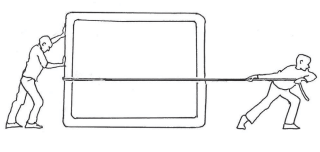 A force is a push or a pull.
A force is a push or a pull.
Contact and Non-Contact Forces
- Contact Force: A force between two objects that are touching.
Examples: Pushing a trolley, kicking a ball, lifting a spanner, biting an apple. - Non-Contact Force: A force between two objects that are not touching.
Examples:
- Gravitational Force: The Earth pulls objects toward its center without contact (e.g., a ball falls back to the ground when thrown up).
- Magnetic Force: Attraction or repulsion between magnets (e.g., a north pole attracts a south pole).
- Electric Force: Attraction or repulsion between charged objects (e.g., static electricity causing sparks when pulling off a jersey).
Forces in Technology
- Force Transfer: Forces are transferred using systems like hydraulics, levers, gears, pulleys, and cranks.
Example: A crane transfers forces to lift heavy loads. - Force Multiplication: Mechanical advantage in hydraulics, levers, gears, and pulleys increases the effect of forces.
Example: A small push on a lever can lift a heavy object. - Loads on Structures: Forces in structural members include tension, compression, bending, shear, and torsion.
Example: A bridge’s beams experience compression and tension. - Resisting Forces: Materials resist forces through:
Triangulation (e.g., triangular supports in bridges).
Different sections (e.g., I-beams for strength).
Different materials (e.g., steel for durability).
Gravitational Force
Definition: The Earth’s gravitational force pulls objects toward its center without physical contact (a non-contact force).
Effect: It causes objects to fall and determines weight based on mass.
Example: A ball thrown upward returns to the ground due to gravity.Nature: Always an attractive force, unlike magnetic and electric forces, which can attract or repel.
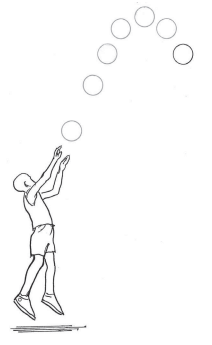
Mass and Matter
Mass Definition: Mass is the amount of matter in an object, measured in kilograms (kg).Examples:
- A 100 mm nail: 10 g (0.01 kg).
- A litre of water: 1 kg.
- A car or small elephant: 1000 kg.
Matter Definition: Matter is anything that occupies space and has mass (e.g., solids, liquids, gases).
Example: Steel has more matter in a small space (high density) than polystyrene, which has air pockets (low density).
 Iron and polystyrene balls
Iron and polystyrene balls

Weight and Its Relationship to Mass
Weight Definition: Weight is the downward force exerted by Earth’s gravity on an object’s mass, measured in newtons (N).Formula:
weight = mass × acceleration of gravity
or
Fg = m × g
- Fg: Weight (N)
- m: Mass (kg)
- g: Acceleration of gravity (9.8 m/s² on Earth)
Example Calculations:
- 1 litre of water (1 kg):
Fg = 1 × 9.8 = 9.8 N - Brass door knob (500 g = 0.5 kg):
Fg = 0.5 × 9.8 = 4.9 N
Difference:
- Mass is the amount of matter (kg), constant everywhere.
- Weight is the gravitational force (N), varying with gravity (e.g., less on the Moon).
- Example: A soccer player with 80 kg mass has a weight of 80 × 9.8 = 784 N on Earth.
Magnetic Force
Definition: A non-contact force of attraction or repulsion between magnets or magnetic materials.Poles: Magnets have a north pole and a south pole.
- Unlike poles attract (north attracts south).
- Like poles repel (north repels north, south repels south).
Strength: Strongest near the magnet, weakens with distance.
Example: Two magnets aligning or pushing apart based on pole orientation.
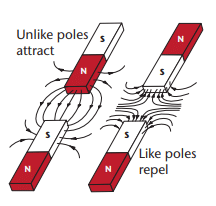
Electric Force
Definition: A non-contact force of attraction or repulsion between electrically charged objects.Charges: Positive (+) or negative (-).
- Unlike charges attract (+ attracts -).
- Like charges repel (+ repels +, - repels -).
Example: Static electricity causing sparks when pulling off a jersey in the dark.
Similarity: Like magnetic forces, electric forces can attract or repel, unlike gravitational forces, which only attract.
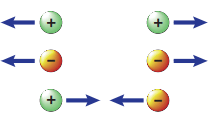
Kinds of Forces
This section explores different types of forces that act on structural members, causing stretching, squashing, bending, shearing, or twisting.
Tensile Force
Definition: A tensile force is a pulling or stretching force that causes an object to stretch.
Explanation: An object under tension is pulled from opposite ends, like a rope being tugged.
Symbol: Represented by arrows pointing away from the object.
Examples:
- Steel cables stabilizing a cell phone tower.
- Ropes in a block and tackle system.
- Steel rods in cross-bracing of buildings.
- Tie beams in wooden roof trusses.
- Bolts holding machine parts together.
Effect: If the tensile force is too strong, the object may deform (stretch out of shape) or fracture (break).
Example: A bolt snapping under excessive pulling force.
Compressive Force
Definition: A compressive force is a pushing or squashing force that causes an object to compress.Explanation: An object under compression is pushed together, like a column supporting weight.
Symbol: Represented by arrows pointing toward the object.
Examples:
- Vertical steel members of a cell phone tower.
- Columns in concrete-framed buildings.
- Girders and struts in wooden trusses.
- Gaskets, disc brakes, and piston rods in cars.
Effect: If the compressive force is too great, the object may buckle (bend) or crush.
Example: A concrete column breaking and its reinforcing bars buckling.
Bending Force
Definition: A bending force causes an object to bend, typically affecting beams.Explanation: Beams are horizontal structural members that carry vertical loads (dead load: beam’s weight; live load: added weight) and resist bending and shear forces.
Cause: Bending occurs due to loads and reactions at support points, with maximum bending in the beam’s middle.
Symbol: Not explicitly shown, but bending is implied by load distribution.
Examples:
- Horizontal members in steel, concrete, or wood-framed buildings.
- Purlins supporting corrugated iron roofs.
- Steel beams in steel-framed buildings.
Effect: Overloading may cause deformation (excessive bending) or fracturing (breaking).
Example: A beam in an overhead crane bending under heavy load.
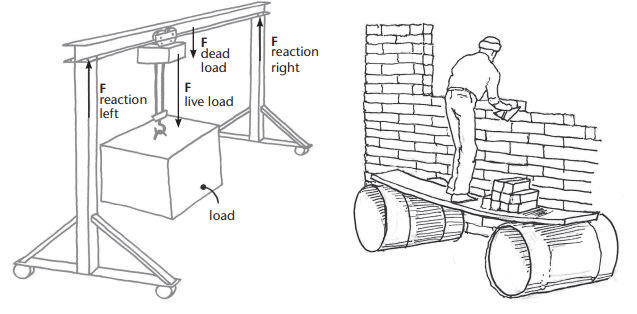
Shear Force
Definition: Shear forces are unaligned forces that push one part of an object in one direction and another part in the opposite direction, causing a shearing action.Explanation: Shear occurs when forces slide past each other, like cutting with scissors.
Symbol: Represented by opposing arrows sliding past each other.
Examples:
- Tin snips cutting sheet metal.
- Teeth shearing a banana during a bite.
- Fingers bending over a window sill under body weight.
Effect: Shear forces can deform or cut the object.
Example: A metal sheet tearing apart under shear force.
 Tin snips cut the sheet metal with a shearing action
Tin snips cut the sheet metal with a shearing action
Torsion
Definition: Torsion is the twisting effect on an object when one end is held firm and the other is turned, caused by a turning action (not a force itself).Explanation: Torsion creates shear stress, like twisting a screwdriver to remove a screw.
Examples:
- Screws and bolts under twisting force.
- Drive shafts in cars.
- Drill bits.
- Vertical columns of tower cranes when the jib faces wind.
- Torsion bars in vehicle suspension systems.
- Springs in mousetraps.
Effect: Excessive torsion can cause deformation or failure (e.g., a screw snapping).
Example: Chalk breaking with a classic torsion failure when twisted.
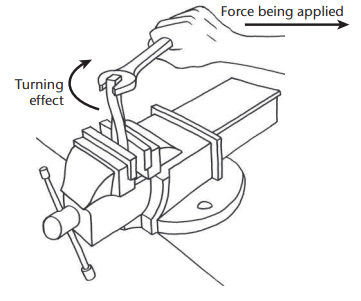
Normal Force
Definition: The normal force (FN) is the perpendicular force exerted by a surface on an object touching it.Explanation: When objects touch, a contact force acts. If the surface is flat, the upward force perpendicular to the surface is the normal force.
Characteristics:
- Acts at a 90° angle to the surface (normal means perpendicular).
- On a horizontal surface, the normal force equals the object’s weight but acts in the opposite direction.
Example: A book on a table experiences a normal force from the table, equal and opposite to its weight.
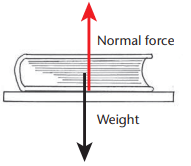
Frictional Force
Definition: The frictional force (Ff) is the force parallel to a surface that opposes an object’s motion across it, acting opposite to the direction of motion.Explanation: Friction occurs when two surfaces slide past each other, resisting movement.
Factors Affecting Friction:
- Surface Roughness: Rougher surfaces create more friction.
- Normal Force: Greater weight increases the normal force, increasing friction.
Examples:
- Striking a match generates heat to light it.
- Sliding a bolt to lock a gate requires overcoming friction.
- Non-slip rubber or steel surfaces prevent slipping.
Characteristics:
- Acts parallel to the surface.
- Opposes the direction of motion.
- Example: Pushing a block right, friction acts left.
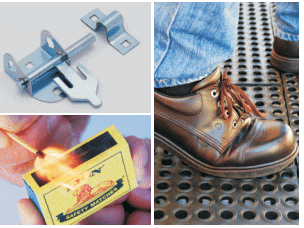
Force Diagrams and Free Body Diagrams
This section explains how to represent forces acting on objects using force diagrams and free body diagrams.
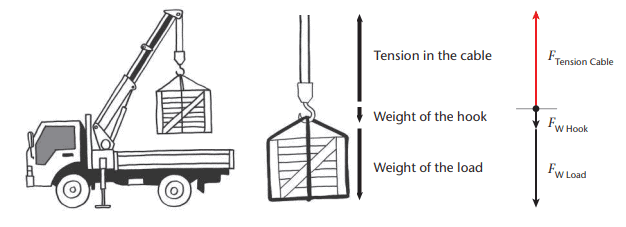
Force Diagrams
Definition: A force diagram is a picture of the object of interest with all forces acting on it drawn as arrows, each starting at its point of application.
Features:
Shows the object and all interacting objects.
Arrows represent forces, indicating:
- The line of action (direction).
- The point of application (where the force acts).
- Descriptive names (e.g., “weight of the car”).
Example: A crane’s hook with forces like the weight of the load and tension in the cable, shown as arrows on the hook.
Free Body Diagrams
Definition: A free body diagram represents the object of interest as a dot, with all forces acting on it drawn as arrows pointing away from the dot.Features:
- Isolates the object from its surroundings, showing only forces.
- The object is a dot, simplifying analysis.
- Arrows show force magnitude (length) and direction, using symbolic names (e.g., FN for normal force).
- If multiple forces act in the same direction, arrows are drawn tail-to-head.
Example: For a car on a jack, the jack’s free body diagram shows a dot with arrows for half the car’s weight, the jack’s weight, and the ground’s normal force.
Drawing Force and Free Body Diagrams
Process:- Start with a space diagram (a picture of the physical situation, e.g., a crane unloading a box).
- Create a force diagram, showing the object and all forces as arrows.
- Convert to a free body diagram, replacing the object with a dot and drawing force arrows.
Example (Car on a Jack):
- Force Diagram (Jack): Shows the jack with arrows for half the car’s weight (down), jack’s weight (down), and normal force from the ground (up).
- Free Body Diagram (Jack): A dot with arrows for the same forces, pointing away.
- Force Diagram (Car): Shows the car with arrows for its weight (down), normal force from the jack (up), and normal force from the ground on two wheels (up).
- Free Body Diagram (Car): A dot with arrows for the same forces.
Resultant, Equilibrant, and Equilibrium
This section covers how multiple forces combine, balance, and create equilibrium in one dimension.
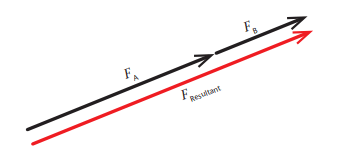 Two force vectors and their resultant force vector
Two force vectors and their resultant force vector
Resultant
Definition: The resultant is the single force that produces the same effect as two or more forces acting together.Explanation: When multiple forces act on an object, their combined effect is represented by one resultant force.
Methods to Find Resultant:
Graphical Method:
- Draw force vectors to scale (e.g., 1 cm = 100 N).
- Place arrows tail-to-head.
- Measure the resultant arrow’s length and direction.
- Example: A rugby player (900 N) and two netball players (400 N each) push a car. Scale: 1 cm = 100 N. Draw 9 cm (900 N) and two 4 cm (400 N) arrows tail-to-head. Resultant = 17 cm = 1700 N.
Calculation:
- Add forces, considering direction (positive or negative).
- Example: 900 N + 400 N + 400 N = 1700 N.
Equilibrant
Definition: The equilibrant is the force equal in magnitude to the resultant but acting in the opposite direction to balance it.Explanation: The equilibrant cancels the resultant, making the net force zero.
Methods to Find Equilibrant:
Graphical Method:
- Find the resultant, then draw an arrow of the same length in the opposite direction.
- Example: Two forces (12 N and 18 N east) have a resultant of 30 N east (15 cm at 1 cm = 2 N). Equilibrant = 30 N west (15 cm west).
Calculation:
- Calculate the resultant, then reverse its direction.
- Example: 12 N + 18 N = 30 N east; equilibrant = 30 N west.
Equilibrium
- Definition: A body is in equilibrium when the resultant force on it is zero, meaning all forces are balanced.
- Explanation: In equilibrium, the object does not accelerate (it may be at rest or moving at constant velocity).
- Equilibrium in One Dimension: Forces along a straight line cancel out.
Example: A key ring pulled by three elastic bands returns to its original position when released, as the forces balance (resultant = 0).
Importance: Understanding equilibrium helps design stable structures, like bridges or cranes, where forces must balance to prevent collapse.
Points to Remember
- A force is a push or pull, a vector quantity with magnitude and direction, measured in newtons (N).
- Contact forces require touching (e.g., pushing a trolley); non-contact forces act at a distance (e.g., gravity, magnetic, electric).
- Weight (Fg = m × g) is the gravitational force on an object’s mass (m), with g = 9.8 m/s² on Earth.
- Mass is the amount of matter in an object (kg); matter occupies space and has mass.
- Tensile forces stretch, compressive forces squash, bending forces bend, shear forces slide parts oppositely, and torsion twists objects.
- Normal force (FN) is perpendicular to a surface; frictional force (Ff) opposes motion parallel to the surface.
- Force diagrams show objects with force arrows; free body diagrams show a dot with force arrows.
- The resultant combines multiple forces; the equilibrant balances the resultant; equilibrium occurs when the resultant is zero.
Difficult Words
- Force: A push or pull that affects an object’s motion or shape.
- Vector: A quantity with both magnitude (size) and direction.
- Contact Force: A force between touching objects.
- Non-Contact Force: A force between objects not touching.
- Gravitational Force: The Earth’s pull on objects toward its center.
- Mass: The amount of matter in an object (kg).
- Matter: Anything that occupies space and has mass.
- Weight: The gravitational force on an object’s mass (N).
- Tensile Force: A pulling force that stretches an object.
- Compressive Force: A pushing force that squashes an object.
- Bending Force: A force that causes an object to bend.
- Shear Force: Forces that slide parts of an object in opposite directions.
- Torsion: A twisting effect from a turning action.
- Normal Force: The perpendicular force from a surface on an object.
- Frictional Force: The force opposing motion parallel to a surface.
- Force Diagram: A picture showing an object with force arrows.
- Free Body Diagram: A dot representing an object with force arrows.
- Resultant: The single force equivalent to multiple forces.
- Equilibrant: The force that balances the resultant.
- Equilibrium: When the resultant force on an object is zero.
Summary
This chapter explores forces, defined as pushes or pulls that affect objects’ motion or shape. Forces are vectors with magnitude and direction, measured in newtons (N). Contact forces occur between touching objects (e.g., pushing a trolley), while non-contact forces act at a distance (e.g., gravitational, magnetic, electric). The Earth’s gravitational force pulls objects downward, determining weight (weight = mass × 9.8 m/s²). Mass measures matter (anything with space and mass), while weight is the gravitational force on that mass. Forces in structures include tensile (stretching), compressive (squashing), bending (bending beams), shear (sliding parts), and torsion (twisting). Normal forces act perpendicular to surfaces, and frictional forces oppose motion parallel to surfaces, depending on surface roughness and normal force. Force diagrams show objects with force arrows, while free body diagrams isolate objects as dots with force arrows. The resultant combines multiple forces into one equivalent force, the equilibrant balances the resultant, and equilibrium occurs when the resultant is zero, ensuring no acceleration. These concepts are vital for analyzing and designing stable structures in engineering.
FAQs on Forces Chapter Notes - Technical Science for Grade 10
| 1. What are the different kinds of forces in physics? |  |
| 2. What is torsion and how does it relate to forces? |  |
| 3. What are force diagrams and free body diagrams, and why are they important? |  |
| 4. What is the difference between resultant, equilibrant, and equilibrium? |  |
| 5. What are some key points to remember about forces in physics? |  |














